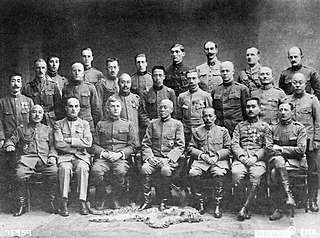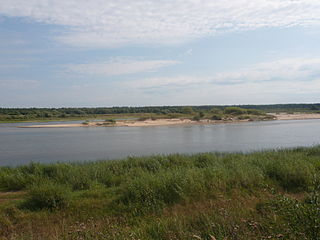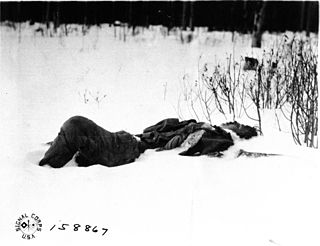Related Research Articles

The Northern Dvina is a river in northern Russia flowing through Vologda Oblast and Arkhangelsk Oblast into the Dvina Bay of the White Sea. Along with the Pechora River to the east, it drains most of Northwest Russia into the Arctic Ocean. It should not be confused with the Western Dvina, with which it is not connected.

Arkhangelsk Oblast is a federal subject of Russia. It includes the Arctic archipelagos of Franz Josef Land and Novaya Zemlya, as well as the Solovetsky Islands in the White Sea. Arkhangelsk Oblast also has administrative jurisdiction over the Nenets Autonomous Okrug (NAO). Including the NAO, Arkhangelsk Oblast has an area of 587,400 square kilometres (226,800 sq mi), it's the largest of first-level administrative divisions in Europe. Its population was 1,227,626 as of the 2010 Census.

The American Expeditionary Force, North Russia was a contingent of about 5,000 United States Army troops that landed in Arkhangelsk, Russia as part of the Allied intervention in the Russian Civil War. It fought the Red Army in the surrounding region during the period of September 1918 through to July 1919.

The Allied intervention in the Russian Civil War consisted of a series of multi-national military expeditions that began in 1918. The initial impetus behind the interventions was to secure munitions and supply depots from falling into the German Empire's hands, particularly after the Bolsheviks signed the Treaty of Brest-Litovsk, and to rescue the Allied forces that had become trapped within Russia after the 1917 October Revolution. After the Armistice of 11 November 1918, the Allied plan changed to helping the White forces in the Russian Civil War. After the Whites collapsed, the Allies withdrew their forces from Russia by 1925.

The Eight-Nation Alliance was a multinational military coalition that invaded northern China in 1900 during the Boxer Rebellion, with the stated aim of relieving the foreign legations in Beijing, which was being besieged by the popular Boxer militiamen, who were determined to remove foreign imperialism in China. The allied forces consisted of about 45,000 troops from the eight nations of Germany, Japan, Russia, Britain, France, the United States, Italy, and Austria-Hungary. Neither the Chinese nor the quasi-concerted foreign allies issued a formal declaration of war.

The North Russia intervention, also known as the Northern Russian expedition, the Archangel campaign, and the Murman deployment, was part of the Allied intervention in the Russian Civil War after the October Revolution. The intervention brought about the involvement of foreign troops in the Russian Civil War on the side of the White movement. The movement was ultimately defeated, while the British-led Allied forces withdrew from Northern Russia after fighting a number of defensive actions against the Bolsheviks, such as the Battle of Bolshie Ozerki. The campaign lasted from March 1918, during the final months of World War I, to October 1919.

The Siberian intervention or Siberian expedition of 1918–1922 was the dispatch of troops of the Entente powers to the Russian Maritime Provinces as part of a larger effort by the western powers, Japan, and China to support White Russian forces and the Czechoslovak Legion against Soviet Russia and its allies during the Russian Civil War. The Imperial Japanese Army continued to occupy Siberia even after other Allied forces withdrew in 1920.

The Russian route M8 "Kholmogory" or Yaroslavl highway, is a major trunk road that links Moscow to the Russian North in general and the sea harbour of Arkhangelsk in particular. The road runs north of Moscow across a distance of 1271 kilometres through Mytishchi, Pushkino, Sergiyev Posad, Pereslavl-Zalessky, Rostov the Great, Yaroslavl, Danilov, Gryazovets, Vologda, Kadnikov, Velsk, Kholmogory, and Arkhangelsk, ending up in the city of Severodvinsk. It passes Moscow, Vladimir, Yaroslavl, Vologda, and Arkhangelsk Oblasts.
The Battle of Tulgas was part of the North Russia Intervention into the Russian Civil War and was fought between Allied and Bolshevik troops on the Northern Dvina River 200 miles south of Arkhangelsk. It took place on the day the armistice ending World War I was signed, November 11, 1918, and is sometimes referred to as "The Battle of Armistice Day." Shortly before the battle, the freezing of the local waterways resulted in the cutting off of the Tulgas Garrison from outside assistance, and the freezing of the ground let the Bolsheviks move troops to surround Tulgas. The Bolsheviks used this opportunity and their superior numbers to try to attack and conquer the isolated outpost, but were driven back with severe losses.

The Japanese Siberian Intervention of 1918–1922 was a dispatch of Japanese military forces to the Russian Maritime Provinces, as part of a larger effort by western powers and Japan to support White Russian forces against the Bolshevik Red Army during the Russian Civil War. The Japanese suffered 1,399 killed and another 1,717 deaths from disease. Japanese military forces occupied Russian cities and towns in the province of Primorsky Krai from 1918—1922.

The GULAG Operation was a German military operation in which German and Soviet anti-communist troops were to create an anti-Soviet resistance movement in Siberia during World War II by liberating and recruiting prisoners of the Soviet GULAG system. Despite ambitious plans, only a small group of former Soviet POWs was airlifted to the Komi Republic in June 1943. Members of the group were captured or killed days after landing.

The Russian Civil War (1917–1921) began after the provisional government collapsed and the Bolshevik party assumed power in October 1917. The principal fighting occurred between the Bolshevik Red Army and the forces of the White Army, a group of loosely allied anti-Bolshevik forces. During the war several foreign armies took part, mostly fighting against the Red Army—including the Western allies—and many foreign volunteers fought for both sides. Other nationalist and regional political groups also participated in the war, including the Ukrainian nationalist Green Army, the Ukrainian anarchist Insurgent Army and Black Guards, and warlords such as Ungern von Sternberg. Despite some pressure from Britain, the Australian Prime Minister, William Hughes, had refused to commit forces to Russia following the end of World War I in 1918.

Alexander Alexandrovich Samoylo was a commander in the Imperial Russian Army and Red Army during World War I and the Russian Civil War.

Shenkursky District is an administrative district (raion), one of the twenty-one in Arkhangelsk Oblast, Russia. As a municipal division, it is incorporated as Shenkursky Municipal District. It is located in the south of the oblast and borders with Vinogradovsky District in the north, Verkhnetoyemsky District in the east, Ustyansky District in the southeast, Velsky District in the south, Nyandomsky District in the west, and with Plesetsky District in the northwest. The area of the district is 11,298 square kilometers (4,362 sq mi). Its administrative center is the town of Shenkursk. Population: 15,196 (2010 Russian census); 18,680 (2002 Census); 22,597 (1989 Soviet census). The population of Shenkursk accounts for 37.5% of the district's total population.

The Battle of Bolshie Ozerki was a major engagement fought during the Allied North Russia Intervention in the Russian Civil War. Beginning on March 31, 1919, a force of British, American, Polish, and White Russian troops engaged several Red Army partisan regiments at the village of Bolshie Ozerki. Although the initial Allied attacks were repelled, the outnumbered Allies managed to repel the Soviet flanking attempts that followed and the Red Army was later ordered to withdraw. Allied forces began to withdraw rapidly from northern Russia shortly thereafter.
The Battle of Vystavka was the defense of the village of Vystavka and several neighboring villages by Allied forces against a series of attacks from the Red Army during the Allied intervention in the Russian Civil War in late January-early March, 1919.

Tulgas is a traditional territory in Arkhangelsk Oblast, Russia, associated with the river Tulgas, a tributary of Northern Dvina.

The Riga offensive, also called the Battle of Jugla or the Battle of Riga, took place in early September 1917 and was last major campaign on the Eastern Front of World War I before the Russian Provisional Government and its army began disintegrating.

The Northern Front was a front of the Red Army during the Russian Civil War which was formed on 15 September 1918 to fight the troops of the interventionists and White Guards in the Northwest, North and Northeast of the Soviet Republic. The Northern Front covered the area between Pskov and Vyatka. It bordered the Eastern Front of the Red Army along the Balakhna - Yarensk - Glazov - Cherdyn, Cherdyn line. The Front headquarters were located in Yaroslavl.
The 6th Army was a field army of the Red Army during the Russian Civil War, which was formed twice.
References
- ↑ John W. Long, "Vaga River Front, Northern Russia (1918-1919)", in: Beede, 1994
- Beede, Benjamin R. (1994). The War of 1898, and U.S. Interventions, 1898-1934: An Encyclopedia . Taylor & Francis. ISBN 0824056248.